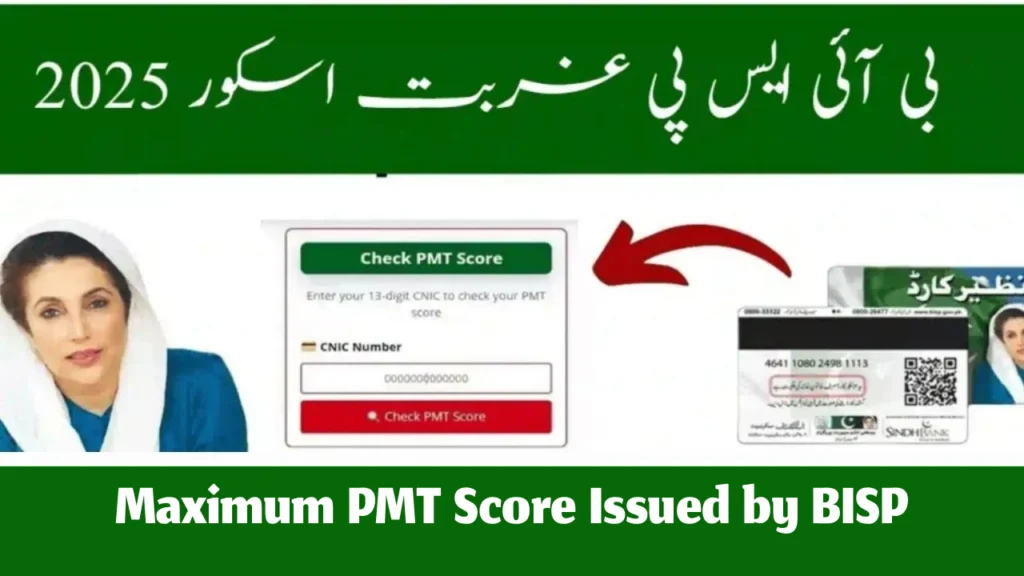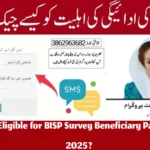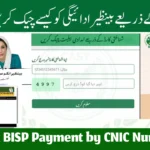
Unraveling the Himmat Card Mystery
Hey there! If you’ve been wondering, “What is the maximum PMT score issued by BISP for Himmat Card eligibility?” you’re in the right place. Let’s break it down like we’re chatting over a cup of tea. The Himmat Card is a super cool initiative by the Punjab government in Pakistan to help people with disabilities (PWDs) get financial support. But to qualify, you need to meet certain rules, and one big piece of the puzzle is something called the PMT score. Don’t worry if that sounds like a secret code—it’s not! We’ll explain it step-by-step, sprinkle in some 2025 updates, and make sure you walk away feeling like an expert.
So, grab a snack, get comfy, and let’s dive into what this PMT score is, why it matters, and how you can make sure you’re in the running for the Himmat Card. Ready? Let’s go!
What’s the Himmat Card All About?
Before we get into the nitty-gritty of PMT scores, let’s talk about the Himmat Card itself. Imagine it as a special pass that unlocks financial help for people with disabilities in Punjab, Pakistan. It’s like a high-five from the government, saying, “We’ve got your back!” Right now, the Himmat Card gives eligible folks a quarterly stipend of Rs. 10,500 to help cover daily expenses. And guess what? In the future, the government plans to add even more services to this card, like healthcare benefits or job support. Pretty awesome, right?
But here’s the catch: not everyone can get the Himmat Card. The government uses a system called the Proxy Means Test (PMT) to figure out who qualifies. This PMT score is like a report card for your household’s financial situation. Let’s unpack that next.
Understanding the PMT Score: The Key to Eligibility
Okay, let’s talk about this PMT score thing. The Proxy Means Test is a fancy way of saying, “We’re going to look at your family’s situation to see if you need help.” It’s a number between 0 and 100 that shows how financially vulnerable your household is. The lower your score, the more likely you are to qualify for programs like the Himmat Card or the Benazir Income Support Programme (BISP).
Here’s how it works in simple terms:
- Data Collection: The government sends people to your home (or you visit a registration center) to collect info about your family. They ask things like how many people live with you, what your house is like, and whether you own stuff like a car or a fridge.
- Score Calculation: All that info gets plugged into a system that spits out a number—your PMT score. A lower score means you’re in greater need of financial help.
- Eligibility Check: For programs like the Himmat Card, the government sets a maximum PMT score. If your score is below that number, you’re in!
Think of it like a video game: you need to “score” low enough to unlock the prize (in this case, the Himmat Card). So, what’s the magic number for the Himmat Card in 2025? Let’s find out.
The Maximum PMT Score for Himmat Card Eligibility in 2025
Alright, here’s the big reveal! For the Himmat Card in 2025, the maximum PMT score issued by BISP is 45. That means if your household’s PMT score is 45 or lower, you could qualify for the Himmat Card, assuming you meet the other requirements (like having a disability certificate). If your score is above 45, the system might say, “Hmm, your household seems to be doing okay financially,” and you might not make the cut.
Now, this number—45—is higher than the PMT cutoff for some other BISP programs, like the Benazir Kafaalat Program, which has a cutoff of 32 (or 37 for households with disabled members). Why the difference? The Himmat Card is specifically for people with disabilities, so the government has relaxed the rules a bit to include more folks who need support. It’s like giving a little extra wiggle room to make sure no one slips through the cracks.
Why the PMT Score Matters
You might be thinking, “Okay, cool, but why should I care about this number?” Great question! The PMT score is the backbone of how the government decides who gets help. Here’s why it’s a big deal:
- Fairness: The PMT score helps make sure aid goes to the people who need it most, like families living in tough conditions or those with limited income.
- Transparency: It’s a data-driven system, so it’s not just someone picking names out of a hat. Your score is based on real info about your life.
- Access to Benefits: A low PMT score can open doors to not just the Himmat Card but other programs like BISP’s Kafaalat or Taleemi Wazaif (education stipends for kids).
But here’s the tricky part: if your PMT score is too high, you might miss out. That’s why it’s super important to understand how to check your score and keep your info up to date. Let’s talk about that next.
How to Check Your PMT Score in 2025
Checking your PMT score is easier than you might think, thanks to some awesome updates in 2025. The government has made it super simple to check your eligibility from the comfort of your home. Here’s how you can do it:
- Use the 8171 SMS Service:
- Grab your phone and type your 13-digit CNIC (Computerized National Identity Card) number.
- Send it to 8171.
- Wait a few seconds, and you’ll get a reply telling you your PMT score and whether you’re eligible for programs like the Himmat Card.
- Visit the BISP Web Portal:
- Head to the official BISP website (8171.bisp.gov.pk).
- Enter your CNIC number in the eligibility check form.
- Type in the captcha code (you know, that annoying “prove you’re not a robot” thing).
- Hit submit, and boom—you’ll see your PMT score and eligibility status.
- Stop by a BISP Office:
- If you’re not a tech wizard, no worries! Visit your nearest BISP Tehsil Office.
- Bring your CNIC and ask the staff to check your PMT score. They’ll look it up in their system and let you know.
Pro Tip: If you’re checking for the Himmat Card, make sure you mention that you’re a person with a disability. The staff might ask for your disability certificate to confirm.
Latest Updates for Himmat Card in 2025
The Himmat Card program is getting some exciting upgrades in 2025. Here’s what’s new:
- Phase 2 Rollout: The Punjab government kicked off Phase 2 of the Himmat Card in April 2025, aiming to reach even more people with disabilities across the province.
- Increased Funding: The budget for the Himmat Card has grown, meaning more folks can get the Rs. 10,500 quarterly stipend.
- Easier Registration: The government has set up more registration centers and mobile vans to reach remote areas, so no one gets left out.
- Future Benefits: Plans are in the works to add healthcare services, job training, and other perks to the Himmat Card. Stay tuned!
These updates show that the government is serious about making life better for people with disabilities. But to take advantage of them, you need to make sure your PMT score is in the right range.
Who Can Get the Himmat Card?
Okay, so we know the maximum PMT score is 45, but what else do you need to qualify for the Himmat Card? Here’s the lowdown:
- Disability Certificate: You must have an official certificate from the government proving you have a disability. This is non-negotiable!
- PMT Score of 45 or Lower: As we mentioned, your household’s PMT score needs to be 45 or below.
- Resident of Punjab: The Himmat Card is a Punjab-specific program, so you need to live in Punjab, Pakistan.
- Registered with BISP: You’ll need to be part of the BISP system, which means completing the National Socio-Economic Registry (NSER) survey.
If you check all these boxes, you’re in a great position to apply for the Himmat Card. But what if your PMT score is too high? Don’t panic—there’s hope!
What to Do If Your PMT Score Is Too High
So, you checked your PMT score, and it’s above 45. Bummer! But don’t give up just yet. Sometimes, scores are high because the info in the system is outdated or incorrect. Here’s how to fix it:
- Request a Re-Survey: Visit a BISP Tehsil Office and ask for a new NSER survey. This is like hitting the refresh button on your household’s data. If your financial situation has changed (like you lost a job or sold some assets), a re-survey could lower your score.
- Update Your Info: Make sure the BISP system has the latest details about your family, like income, number of dependents, or living conditions.
- Double-Check for Errors: Sometimes, mistakes happen during data entry. Maybe someone accidentally marked that you own a fancy car when you don’t even have a bicycle! Ask the BISP staff to review your records.
By updating your info, you might bring your PMT score down to 45 or below, making you eligible for the Himmat Card.
Common Mistakes to Avoid When Applying
Nobody’s perfect, but when it comes to applying for the Himmat Card, you’ll want to avoid these rookie mistakes:
- Not Getting a Disability Certificate: Without this, you can’t even apply, no matter how low your PMT score is.
- Ignoring the NSER Survey: If you haven’t done the survey, your info isn’t in the system, and you won’t get a PMT score.
- Using Fake Info: Be honest when filling out forms. If the government catches you fudging the numbers, you could be disqualified.
- Missing Deadlines: Some registration phases have deadlines, so keep an eye on announcements from BISP or the Punjab government.
- Not Checking Your Status: Even if you think you’re eligible, always double-check your PMT score and application status to avoid surprises.
Avoiding these pitfalls will make your application process smoother than a sunny day at the park.
Benefits of the Himmat Card
Why bother with all this PMT score stuff? Because the Himmat Card comes with some serious perks! Here’s what you get if you qualify:
- Quarterly Cash: Rs. 10,500 every three months to help with daily expenses like food, medicine, or rent.
- Future Services: The government is planning to add things like free healthcare, job training, and education support to the Himmat Card.
- Empowerment: The card is designed to give people with disabilities more independence and support to live their best lives.
- No Hassle: Once you’re approved, the money comes straight to you through banks like HBL or Alfalah, with simple biometric verification.
It’s like having a trusty sidekick that helps you tackle life’s challenges. Who wouldn’t want that?
Step-by-Step Guide to Applying for the Himmat Card
Ready to apply? Here’s a super simple guide to get you started:
- Get Your Disability Certificate:
- Visit a government hospital or authorized medical board to get your disability assessed.
- They’ll issue a certificate if you qualify.
- Complete the NSER Survey:
- Go to a BISP Tehsil Office or a registration center.
- Provide details about your household, like income, family size, and assets.
- This will generate your PMT score.
- Check Your PMT Score:
- Use the 8171 SMS service or BISP web portal to confirm your score is 45 or lower.
- If it’s too high, request a re-survey.
- Apply for the Himmat Card:
- Visit a Himmat Card registration center (check with the Punjab Social Welfare Department for locations).
- Bring your CNIC, disability certificate, and proof of residence.
- Fill out the application form and submit it.
- Wait for Approval:
- The government will verify your info and PMT score.
- If approved, you’ll get a confirmation SMS and can start receiving payments.
- Collect Your Payments:
- Head to an authorized bank (like HBL or Bank Alfalah) with your CNIC.
- Complete biometric verification to get your Rs. 10,500 every three months.
Easy, right? Just follow these steps, and you’ll be on your way to getting the support you deserve.
FAQs About the Himmat Card and PMT Score
Got questions? We’ve got answers! Here are some common questions people ask about the Himmat Card and PMT scores:
1. What is the maximum PMT score for Himmat Card eligibility?
The maximum PMT score for the Himmat Card in 2025 is 45. If your score is 45 or lower, you could qualify.
2. How do I know if I have a disability certificate?
A disability certificate is an official document from a government hospital or medical board that confirms you have a disability. Check with your local hospital if you’re unsure.
3. Can I apply for the Himmat Card if I’m already in BISP’s Kafaalat Program?
Yes, as long as you have a disability certificate and your PMT score is 45 or lower, you can apply for both programs.
4. What happens if my PMT score is above 45?
You can request a re-survey at a BISP office to update your household info. If your financial situation has changed, your score might go down.
5. How often do I get Himmat Card payments?
Payments are made every three months (quarterly), and you’ll get Rs. 10,500 each time.
6. Can I check my PMT score without a smartphone?
Absolutely! Just send your CNIC number to 8171 via SMS, or visit a BISP office for help.
Conclusion: Your Path to the Himmat Card
Well, there you have it—everything you need to know about the maximum PMT score for Himmat Card eligibility in 2025! With a PMT score of 45 or lower, a disability certificate, and a quick registration process, you could be on your way to getting Rs. 10,500 every three months to make life a little easier. The Himmat Card is more than just money—it’s a way to feel supported and empowered to live your best life.
So, what’s next? Check your PMT score, gather your documents, and head to a registration center. If you hit any roadblocks, don’t stress—just visit a BISP office or call their helpline. You’ve got this! Keep your info updated, avoid common mistakes, and stay hopeful. The Himmat Card is all about giving you the support you deserve, and with a little effort, you can make it happen.
Got more questions? Drop by a BISP office or send a quick SMS to 8171. Here’s to unlocking the benefits of the Himmat Card and making 2025 your year to shine!

